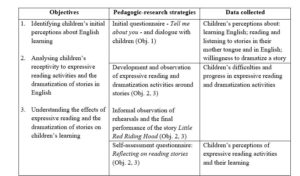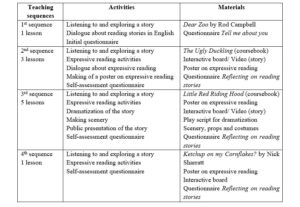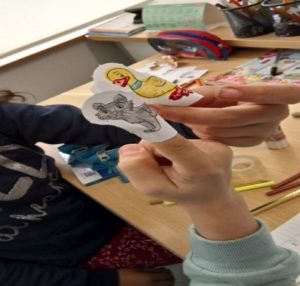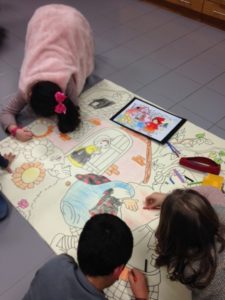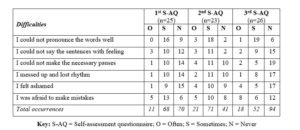| Expressive Reading and Dramatization of Stories in Teaching English to Young Learners
Luciana Cabral Pereira, Flávia Vieira and Aurora Teófilo |
Download PDF |
Abstract
The paper presents an action research project developed in the practicum of the Master Degree in Teaching English in Primary School at the University of Minho, Portugal, focusing on expressive reading and the dramatization of stories in a 4th grade English class. The project objectives were: to identify initial perceptions of children about English language learning; to analyse their receptivity to expressive reading and the dramatization of stories in English; and to understand the effects of expressive reading and the dramatization of stories on learning. After a phase of context analysis, four teaching sequences were developed around four picture stories, with a particular focus on one of the stories that was dramatized and presented publicly. Data was collected through learner questionnaires and informal observations of learner performance. Results allowed us to conclude that the pedagogical experience was successful in this class. It promoted children’s contact with stories in English and stimulated their interest for expressive reading and the dramatization of stories, along with the development of language skills.
Keywords: teaching English to young learners; stories; expressive reading; dramatization
Biodata:
Luciana Cabral Pereira (PhD) teaches at Instituto Politécnico de Bragança. She works in the fields of Didactics of Languages and Literature.
Flávia Vieira (PhD) is full professor at the University of Minho (Portugal). She works in the fields of pedagogy for autonomy in language education, reflective teacher education, and pedagogy in higher education.
Aurora Teófilo is a primary school teacher of English at Agrupamento de Escolas Miguel Torga, Sabrosa (Portugal). She was the school cooperating teacher in the intervention project: Expressive Reading of Stories in Teaching English to Young Learners. [end of page 45]
Introduction
The practicum model in teaching master degrees at the University of Minho entails the development of small-scale, learner-centred action research projects where student teachers explore a teaching topic and collect data to evaluate teaching and learning (see Vieira, 2016). This paper presents a project developed by the first author (Pereira, 2018) in the practicum of the Master’s Degree in Teaching English in Primary School. It was carried out in a 4th grade class in a Portuguese primary school during the school year of 2017/2018, with the supervision of the second author as the faculty supervisor and third author as the school cooperating teacher.
Since 2015/16, English has been a compulsory subject in grades 3 and 4 in primary education in Portugal, which is taught for two hours a week by specialist teachers. The use of stories for developing children’s communicative competences and creativity is recommended in national guidelines. Children’s stories are broadly favourable to the development of language skills, intercultural competence and citizenship values (Ellis & Brewster, 2014), thus representing a useful teaching tool to promote learning.
The universe of children’s stories was central to this project as a starting point for developing reading and language skills, but the primary focus was on expressive reading and dramatization, which are seldom explored in English classes. Drama activities were recommended in the national guidelines produced about one decade ago when English was introduced as an optional extra-curricular activity in primary schools (Dias & Toste, 2006). In a research synthesis on the use of educational drama in L2 learning, Belliveau and Kim (2013, p. 18) point out its major benefits: ‘fostering communication competence, embodied and engaging learning, contextually-situated interaction, confidence and motivation in learning and using language and deeper engagement with literature (…)’. The assumption here was that the expressive reading and dramatization of stories might enhance children’s motivation to read, their understanding of texts, their ability to use language expressively, and their active participation in learning.
The paper is organized into three sections. The first section addresses the importance of stories for expressive reading and dramatization in teaching of English to young learners (TEYL), the second describes the project objectives and methodological procedures, and the third presents main findings. Finally, conclusions and implications for further work are presented. [end of page 46]
The Use of Stories for Expressive Reading and Dramatization in TEYL
In current national guidelines regarding TEYL in primary schools in Portugal, stories are presented as one of the resources to be used in class (Bravo, Cravo & Duarte, 2014, 2015a, 2015b). The benefits of using children’s stories in language learning have been pointed out by several authors (e.g. Ellis, 2016; Ellis & Brewster, 2014; Ghosn, 2013; Kaminsky, 2013; Mourão, 2016; Serrurier-Zucker & Gobbé-Mévellec, 2014). Ellis and Brewster (2014) highlight motivation, personal involvement and language acquisition as major reasons why stories should be used in TEYL. They also stress that as children interpret a story, they engage in an ‘imaginative experience’ that develops their creativity (Ellis & Brewster, 2014, p. 6).
As regards the exploration of picturebooks with children, Ellis (2016, p. 28) points out their potential value for developing ‘multiple literacies’, like visual literacy, emotional literacy, cultural literacy or digital literacy. Ellis further refers to learning literacy, which ‘is linked to learning how to learn and to learner autonomy. It involves developing awareness and understanding of one’s own learning processes, personal preferences and learning strategies’ (Ellis, 2016, p. 30). This means that children talk and reflect about reading processes, difficulties and progress, so as to develop metacognitive knowledge and self-regulation strategies. In the project reported here, the use of children’s stories sought to promote visual literacy, emotional literacy and learning literacy with a focus on expressive reading and dramatization.
According to Norlie (1918), expressive reading engages the reader in interpreting text and conveying the author’s message in a natural and effective way:
By natural is meant that the utterance shall be in the reader’s conversational tone, or as near to it as the message and the occasion will permit. By effective is meant that the utterance shall be given with an emphasis suited to bring out the message for the occasion. By message is meant the thought and feeling and purpose of the author (Norlie, 1918, p. 21).
Through expressive reading, learners explore their own voice for conveying a message with emotional and bodily support, mobilizing a complex set of language skills like comprehension, pronunciation, intonation, rhythm, and fluency. As the author points out, the core of expressive reading is ‘expression’, and ‘To get expression there must be first something [end of page 47] to express, there must be impression’ (Norlie, 1918, p. 22). Stories easily generate reactions and emotions and cause an ‘impression’ that can then be pedagogically explored for ‘expression’. The teacher’s role is crucial on various levels, from providing an adequate reading model to supporting children in practising expressive reading skills and involving them in their self-assessment of performance.
It is important to note that although expressive reading is directly related to reading, it can contribute to the development of expressive language use in general, as expressive speech suggests the speaker has an understanding of content, emotional experiences and artistically expresses the basic components of what is said, and as a result influences the listeners (Gramatkovski, Kochoska, Ristevska & Sivakova, 2017, p. 101).
Expressive reading can be enhanced through the dramatization of stories as a form of Readers Theatre, ‘an interpretative activity in which students repeatedly read a script based on a story in preparation for an oral reading performance’ (Keehn, 2003, p. 43). Readers theatre is often used to improve reading performance with regard to comprehension and fluency (see Griffith & Rasinski, 2004; Keehn, Harmon & Shoho, 2008; Young & Rasinski, 2009). However, story dramatization in our project was mainly understood as a multisensory approach in TEYL as discussed by Serrurier-Zucker & Gobbé-Mévellec (2014). They point out that ‘What is interesting in drama is the process of activating a story, which activates the young learners themselves as they engage physically and emotionally with imaginary situations while communicating in a foreign language’ (Serrurier-Zucker & Gobbé-Mévellec, 2014, p. 15). Therefore, even though the product of dramatization (performance itself) is valued, it is the process of providing a creative language learning experience that is considered most important. As Zafeiriadou (2009, p. 4) argues, ‘a language pedagogy insisting on results instead of process may have a negative effect on students’ motivation and involvement. Educational drama activities should raise positive feelings because they are essentially “play” situations’. The author also stresses the multidimensional value of dramatization as role playing, as it involves spatial dimensions (length, width and height), psychological dimensions (identification, internalisation, and empathy), mental dimensions (representation, assimilation, imagination), social dimensions (participating by taking on a role, interaction and acceptance by others), and personal dimensions (self-development, self-esteem and self-actualisation) (Zafeiriadou, 2009, p. 9). [end of page 48] Drama-based activities in language teaching may entail different levels of teacher direction on a continuum from controlled language exercises and scripted drama to unscripted ‘process drama’, where a pre-text is used to trigger the imagination of a ‘dramatic world’ that unfolds through improvised interactions in class (Liu, 2002). Nevertheless, drama activities always entail putting the learner at the centre of the learning process. According to Davies (1990), this brings about important benefits as regards students’ confidence and motivation to use the language:
Drama in the English language classroom is ultimately indispensable because it gives learners the chance to use their own personalities. It draws upon students’ natural abilities to imitate and express themselves, and if well-handled should arouse interest and imagination. Drama encourages adaptability, fluency, and communicative competence. It puts language into context, and by giving learners experience of success in real-life situations it should arm them with confidence for tackling the world outside the classroom. (Davies, 1990, p. 97)
In arguing for the use of picturebooks as a starting point for drama, Serrurier-Zucker & Gobbé-Mévellec (2014) stress the power of images:
As for the images, they open up avenues for the imagination to give shape to, voice and act out the story; they constitute a factor of motivation and allow for immediate reading where language might be an obstacle; their attractive colours and forms appeal to children’s emotions, contributing to the strong affective charge conveyed by picturebooks. (…) Finally, and this is what interests us most, there is a certain theatrical content in the picturebook which invites its dramatization. (Serrurier-Zucker & Gobbé-Mévellec, 2014, p. 17)
They further underline the symbolic value of theatre in picturebooks as a ‘safe place’ for expressing emotions and dealing with inner concerns:
The characters and the roles they might adopt in the story constitute questioning spaces – and the picturebook becomes an imaginary stage, which can represent a cathartic value for the young reader as well as for the protagonist, a safe space in [end of page 49] which they can experiment by playing. (Serrurier-Zucker & Gobbé-Mévellec, 2014, p. 17)
Expressive reading and dramatization were side by side in the activities developed in the project described below. In fact, while expressive reading was central to it, the dramatization of one of the stories – Little Red Riding Hood – enabled an even more creative exploration of expressive reading with the reinforcement of gestures and physical movements along with echoes, tonal variations expressing feelings and emotions, among other types of expressive manifestations. As Young and Rasinski point out (2009, p. 5), ‘Students are more likely to practice or rehearse (assisted or repeated readings) if they know that they will be performing a reading for an audience’, and rehearsals are thus aimed at ‘reading with meaningful expression to help an audience of listeners better understand the passage’. Children’s learning literacy was also enhanced in the project, through raising their awareness of what expressive reading entails and involving them in self-assessment, which provided invaluable data to assess the approach from their perspective.
Project Objectives and Pedagogic-Research Strategies
The action research project comprised a total of ten 45’ lessons in a 4th grade class of 25 children: 15 girls and 10 boys, aged from 9 to 10 years old. Four teaching sequences were planned and implemented around two picturebooks and two picture stories presented in the adopted coursebook (Abreu & Esteves, 2017):
Dear Zoo, by Rod Campbell (1982/2010) (picturebook)
The Ugly Duckling (picture story from the coursebook)
Little Red Riding Hood (picture story from the coursebook)
Ketchup on my Cornflakes? by Nick Sharratt (1994/2006) (picturebook)
These stories are simple and short enough for training expressive reading, and potentially capable of arousing children’s enthusiasm and interest. The main focus was on Little Red Riding Hood, a traditional story that children already knew in their L1, which was dramatized, performed publicly at school, and later recorded on video to be presented at a national reading contest where it won a prize. Table 1 summarizes the project objectives, pedagogic-research strategies, and type of data collected. [end of page 50]
Table 1. The action research project: objectives, strategies and data collected
At the first stage of the project, the questionnaire Tell me about you was used to learn about children’s perceptions of English learning, the use of stories and their willingness to dramatize a story. All the children showed positive attitudes towards learning English as well as reading and listening to stories, although six expressed doubts regarding the use of stories in English, and two said ‘no’ to the possibility of dramatizing a story. It is important to note that they were already used to listening to stories in English in an extra-class activity given by their English teacher (the third author) in the school library. Actually, this was one of the reasons that motivated the development of this project as an extension of that storytelling activity.
The four teaching sequences, summarized in Table 2, followed a learner-centred approach by encouraging children’s active participation and self-regulation of learning. According to Jiménez Raya, Lamb and Vieira (2007), learner-centredness is at the heart of pedagogy for autonomy in language education. [end of page 51]
Table 2. Summary of the teaching approach
Expressive reading activities were done after listening to and exploring the stories, which involved checking comprehension and learning new vocabulary. The presentation of the stories on video helped to promote visual and emotional literacy, and provided reading models later practised with the teacher’s help. Story sentences and sentence chunks were repeated after the teacher’s model, using body language and expressing different kinds of emotions according to the story or indications provided by the teacher (e.g., Now imagine that he was very angry!). Repetitions were mostly done in chorus to enhance children’s self-confidence, which proved to be very useful to practise pronunciation, accent, rhythm, pauses, and body language. Simple role play activities were also done, where children reproduced dialogues based on the stories (see Figure 1). [end of page 52]
Figure 1. The Ugly Duckling: role playing with finger puppets (coursebook material)
In the case of Little Red Riding Hood, apart from these kinds of activities, the story script was handed out to the children for dramatization purposes (see Appendix 1). Dramatization involved rehearsals in class and outside class, and all the children were involved: one played the narrator, four played the characters (Little Red Riding Hood, Grandma, the Big Bad Wolf and the Woodcutter), and the others played the roles of trees and flowers from the forest, echoing words or lines from the characters to emphasize moods and atmospheres. The children made the scenery (see Figure 2) with the help of other school teachers. The story was performed publicly in school and videotaped for a national reading contest promoted by the Ministry of Education (Ministério da Educação, 2018).
Figure 2. Little Red Riding Hood: making scenery
Two strategies were used for developing the children’s learning literacy as defined by Ellis (2016). The first one was a collective metacognitive dialogue about what expressive reading entails, carried out after the children had first experienced expressive reading tasks. The teacher asked them what is important in expressive reading and noted down their ideas on the [end of page 53] interactive board, in English, for example: ‘it’s fun’; ‘we can play’; ‘it’s great’; ‘it’s beautiful’; ‘role play’; ‘pretend’; ‘pronounce the words well’; ‘express feelings’; ‘adapt the voice’, ‘make sounds’, ‘body language’ (see Figure 3). Later on, children copied those ideas onto a class poster that remained on the classroom wall, and they were invited to comment on their expressive reading performance with reference to that poster.
Figure 3. Collecting children’s ideas on expressive reading
The second strategy for developing the children’s learning literacy was the self-assessment questionnaire Reflecting on reading stories, written in the students’ L1, which was used three times to collect data on:
- what children liked/ didn’t like about the lessons;
- whether they found expressive reading/ speaking easy or not;
- what difficulties they experienced in expressive reading activities;
- whether they were willing to go on reading stories and developing expressiveness, and why.
The data collected was useful for understanding children’s perceptions, to dialogue with them about learning and to adapt teaching if needed, all crucial aspects of learner-centred action research.
Main Findings
Overall, the activities developed around the stories enthused the children and awakened their interest in similar activities throughout the project. Most of them were very interested in listening to stories, doing exercises related to the stories, thinking about and practising expressive reading, and learning new vocabulary. Table 3 summarizes their positive responses [end of page 54] (‘liked’) in the three self-assessment questionnaires, related to the stories The Ugly Duckling, Little Red Riding Hood, and Ketchup on my cornflakes (no self-assessment was done with the first story – Dear Zoo – because it was explored in one lesson and the children filled in the initial questionnaire at the end of that lesson).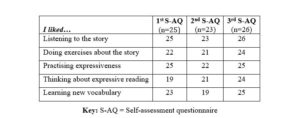
Table 3. Children’s positive responses to lesson activities (self-assessment)
The children also recognized that expressive reading is not very easy and pointed out difficulties, which might be related to linguistic and attitudinal dimensions (Table 4).
Table 4. Children’s perceptions of difficulties (self-assessment)
Difficulties were particularly indicated in the second self-assessment questionnaire related to the story Little Red Riding Hood, probably because this story is more complex than [end of page 55] the others and self-assessment took place when it was still being explored, when children were not yet very confident in reading it expressively. However, the observation of the final performance, which was presented in school for other children and video-recorded for the national contest, showed that they were able to dramatize the story quite successfully, and the fact that they won a prize in the contest is also an indicator of the quality of their work.[i]
Dramatizing this story involved not only memorizing the lines and acting it out, but also making appropriate scenery, stage props and costumes, which involved the use of arts and crafts with the collaboration of families and other teachers in school. All this contributed to enhancing children’s motivation, involvement, and sense of accomplishment. An aspect worth mentioning is that the story dramatization was an inclusive experience, especially for two children with visual impairment, who were able to participate successfully. One of these children played the narrator in the final performance. Also, children who had more difficulties in English felt motivated to participate and improved their self-confidence and language abilities, which was particularly enhanced through chorus repetitions and cooperative learning in pairs and groups.
Conclusion
The project was a significant learning experience for these children. The expressive reading and dramatization of stories appeared to foster high levels of motivation and involvement, a creative and emotional approach to learning, and the development of communicative skills. Dramatization further enhanced meaningful memorization and language use in a communicative setting.
It was also important to engage children in metacognitive reflection, namely through raising their awareness about expressive reading and improving their ability to evaluate difficulties and progress. By collecting learner data through feedback questionnaires, it was possible to get a better understanding of learning processes and adjust teaching strategies as needed. Nevertheless, other strategies might be used to monitor and evaluate the impact of using stories for expressive reading and dramatization, such as stimulated recall techniques and structured observations of children’s performance, which would allow for a better grasp of learning processes and outcomes. [end of page 56]
We are well aware that more time would be needed to develop children’s expressive reading abilities, especially since they had never done this kind of work before. Nevertheless, results show that using picturebooks and picture stories from coursebooks for this purpose is an approach worth exploring, as it enhances children’s motivation to read, their understanding of texts, their ability to use language expressively, and their active engagement in learning. It is therefore our conviction that stories should be explored more than they usually are to enhance the expressive use of language in the classroom, and a wide range of stories can be used, provided they are motivating and appropriate to the children’s level of language. The teacher’s role is central in providing authentic reading models, creating a relaxed learning atmosphere, offering support and positive feedback, and providing opportunities for reflection on learning.
[i] Their performance can be seen at: https://www.youtube.com/watch?v=IPRHjfO9Zx8
Acknowledgments
This work is funded by CIEd – Research Centre on Education, project UID/CED/01661/2019, Institute of Education, University of Minho, through national funds of FCT/MCTES-PT.
Bibliography
Campbell, R. (2010). Dear Zoo. London: Pan-Macmillan.
Sharratt, N. (2006). Ketchup on your Cornflakes? London: Scholastic.
References
Abreu, C. R. & Esteves, V. R. (2017). Let´s Rock 4. Porto: Porto Editora.
Bravo, C., Cravo, A. & Duarte, E. (2014). Metas Curriculares de Inglês, Ensino Básico 1.º Ciclo. Lisboa: Ministério da Educação e Ciência.
Bravo, C., Cravo, A. & Duarte, E. (2015a). Metas Curriculares de Inglês, Ensino Básico 1.º Ciclo: Cadernos de Apoio. Lisboa: Ministério da Educação e Ciência.
Bravo, C., Cravo, A. & Duarte, E. (2015b). Metas Curriculares de Inglês, Ensino Básico: 1.º, 2.º e 3.º Ciclos. Lisboa: Ministério da Educação e da Ciência.
Belliveau, G. & Kim, W. (2003). Drama in L2 learning: A research synthesis. Scenario, 2, 7-27. Retrieved from http://scenario.ucc.ie [end of page 57]
Davies, P. (1990). The use of drama in English language teaching. TESL Canada Journal/ Revue TESL du Canada, 8 (1), 87-99.
Dias, A. & Toste, V. (2006) Ensino do Inglês, 1º Ciclo do Ensino Básico, Orientações Programáticas, 1º e 2º Anos. Lisboa: Direção-Geral de Inovação e de Desenvolvimento Curricular, Ministério da Educação.
Ellis, G. (2016). Promoting ‘learning’ literacy through picturebooks: Learning how to learn. Children’s Literature in English Language Education Journal, 4 (2), 27-40. Retrieved from http://clelejournal.org
Ellis, G. & Brewster, J. (2002). Tell it Again! The New Storytelling Handbook for Primary Teachers. Harlow: Penguin.
Ghosn, I. (2013). Humanizing teaching English to young learners with children’s literature. Children’s Literature in English Language Education Journal, 1 (1), 39-57. Retrieved from http://clelejournal.org
Gramatkovski, B., Kochoska, J., Ristevska, M. &Sivakova, D. (2017). The expressive reading as an opportunity for improvement of the preschool children’s speech. International Journal of Innovation and Research in Educational Sciences, 4(1)1, 99-103. Retrieved from https://www.researchgate.net/publication/313930074
Griffith, L. W. & Rasinski, T. (2004). A focus on fluency: How one teacher incorporated fluency with her reading curriculum. The Reading Teacher, 58 (2), 126–137. DOI:10.1598/RT.58.2.1
Jiménez Raya, M., Lamb, T. & Vieira, F. (2007). Pedagogy for Autonomy in Language Education in Europe. Towards a Framework for Learner and Teacher Development. Dublin: Authentik.
Kaminski, A. (2013). From reading pictures to understanding a story in the foreign language. Children’s Literature in English Language Education Journal, 1 (1), 19-38. Retrieved from http://clelejournal.org
Keehn, S. (2003). The effect of instruction and practice through readers theatre on young readers’ oral reading fluency. Literacy Research and Instruction, 42 (4), 40-61, DOI: 10.1080/19388070309558395
Keehn, S., Harmon, J. & Shoho, A. (2008). A study of readers theater in eighth grade: Issues of fluency, comprehension, and vocabulary. Reading & Writing Quarterly, 24 (4), 335-362, [end of page 58] DOI: 10.1080/10573560802004290
Liu, J. (2002). Process drama in second- and foreign-language classrooms. In G. Bräuer (Ed.), Body and Language. Intercultural Learning Through Drama. Westport: Connecticut & London, pp. 51-70. Retrieved from https://tesoldrama.files.wordpress.com/2010/12/2-processdrama-liu.pdf
Ministério da Educação (2018). Concurso: Conta-nos uma história. Retrieved from http://www.erte.dge.mec.pt/concurso-conta-nos-uma-historia
Mourão, S. (2016). Picturebooks in the primary EFL classroom: Authentic literature for an authentic response. Children’s Literature in English Language Education Journal, 4 (1), 25-43. Retrieved from http://clelejournal.org
Norlie, O. M. (1918). Principles of Expressive Reading, Impression Before Expression. Boston: The GorhamPress.
Pereira, L. C. (2018). A Leitura Expressiva de Histórias Infantis em Língua Inglesa. Practicum report. Braga: University of Minho.
Serrurier-Zucker, C. & Gobbé-Mévellec, E. (2014). The page IS the stage: From picturebooks to drama with young learners. Children’s Literature in English Language Education Journal, 2 (2), 13-30. Retrieved from http://clelejournal.org
Vieira, F. (2016). Investigação pedagógica na formação inicial de professores: Uma estratégia necessária e controversa. Revista Estreia dialogos, 1, 21-39.
Young, C. & Rasinski, T. (2009). Implementing readers theatre as an approach to classroom fluency instruction. The Reading Teacher, 63 (1), 4-13. DOI: 10.1598/RT.63.1.1
Zafeiriadou, N. (2009). Drama in Language Teaching: A Challenge for Creative Development. Issues, 23, 4-9. Retrieved from https://www.academia.edu/5102011/ [end of page 59]
For the Appendix, see the PDF version of this article. [page 60]


